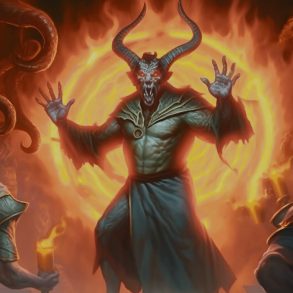What is Command 5E?
Command 5E is a 1st level enchantment spell, which is available natively only to Clerics and Paladins. It only requires a vocal component and takes an action to cast. When cast, a creature the caster can see within 60 ft. must make a Wisdom saving throw, having to spend their next turn following a one-word command if they fail the save. This command must not be directly harmful to the creature and the DM decides how the creature carries out the command. Examples of words to use include:
- Approach – The creature moves as close to you as possible, ending its turn when it gets within 5 ft. of you. This movement must be via the shortest and most direct path.
- Drop – The creature drops anything it is holding and then immediately ends its turn.
- Flee – The creature moves away from you as fast as it is able to.
- Grovel – The creature drops prone and then immediately ends its turn.
- Halt – The creature takes no actions and makes no movement on its turn. A flying creature can move the minimum amount to stay aloft if they need to.
This spell has no effect on a creature if it is undead, if it can’t understand the language the command is made in, or if the command is directly harmful to it.
If you cast this spell with a 2nd level or higher spell slot, you can target one additional creature for every level above 1st, as long as the targets are within 30 ft. of each other. For example, a 4th level casting of Command would target 4 different creatures within 60 ft. of the caster and 30 ft. of each other.
Is Command 5E a good spell?
Command has the potential to completely change the tide of a battle, as a creature losing a turn can snowball into a victory for the other side. Adding into this action economy advantage additional factors, such as the creature maybe not being able to reach the combat on the next free turn if they were told to flee or advantage on melee attacks if they were made to fall prone. However, the nature of the spell has the potential to make it niche depending on the table you play at. It can be easy to go for many sessions unable to use this spell, simply because the monsters don’t understand you, they may be undead, or immune to the charmed condition.
Ways to improve this spell include the Twinned Metamagic to target two targets with a 1st level spell slot and the Glamour Bard’s Mantle of Majesty feature, which allows repeated casting as a bonus action without spending a spell slot. The more languages you know, the more reliable the spell becomes, with telepathy potentially circumventing the language barrier for many creatures depending on your DM.
How can you get Command 5E?
If you find yourself in need of bossing someone around, then fear not! Here is a list of how you can grab this spell:
- Cleric and Paladin – These are the only classes to have it on their spell list.
- Bard (Optional Class Feature) – Using the Optional Class Features from TCoE adds Command to the Bard spell list.
- Oath of Conquest (Paladin Subclass) – These domineering Paladins get it as an always-prepared spell thanks to their Oath Spells feature.
- Oath of the Crown (Paladin Subclass) – Similar to the above, these loyal Paladins get Command as an Oath Spell.
- Knowledge Domain (Cleric Subclass) – These Clerics get this spell as a Domain Spell.
- Order Domain (Cleric Subclass) – As above, so below. These Clerics also get it as a Domain Spell.
- College of Glamour (Bard Subclass) – The Mantle of Majesty feature allows these Bards to cast Command as a bonus action for 1 minute without needing to use spell slots, at the cost of their concentration.
- Divine Soul (Sorcerer Subclass) – These Sorcerers can choose spells from the Cleric spell list.
- Fiend (Warlock Subclass) – Spell is available to pick up for these Warlocks because of their Expanded Spell List feature.
- Divinely Favored (Feat) – Choosing the Good alignment with this feat would let you choose one 1st level Cleric spell, along with the Augury. You can cast both of the spells once per long rest for free or more with any spell slots you may have.
- Fey Touched (Feat) – You can choose Command with this feat because it’s an enchantment spell, boosting a mental stat by +1 and grabbing Misty Step to boot. Great value!
- Magic Initiate (Feat) – Picking the Cleric spell list will get you one casting of Command per long rest and two Cleric cantrips of your choice.
- Strixhaven Initiate (Feat) – Both Lorehold and Silverquill will allow you to choose a 1st level Cleric spell, as well as two of three of the cantrips listed for each school.
How to roleplay the Command 5E spell
Need some help roleplaying the Command spell? Here are some examples to help you out:
- In the heat of battle, the Cleric locks eyes with an ogre charging towards him. He raises his holy symbol, commanding the creature to “Halt!” As the Command spell takes hold, the ogre grinds to a sudden stop, confusion etched on its face as it struggles against the divine mandate.
- Amidst a fierce skirmish against a band of gnolls, the Paladin spies their leader preparing to sound a war horn. Quickly, she points her warhammer at the gnoll, her voice ringing out with a divinely powered “Drop!” The Command forces the gnoll to drop the horn, interrupting their call for reinforcements.
- While chasing a thief through crowded city streets, the Paladin calls out a divinely empowered “Grovel!” Commanding the thief with his spell, the culprit suddenly stops in their tracks and falls prone, compelled to the spot by the power of the command, allowing the party to catch up.
You learned enough to help you get served at the local tavern faster. if you’re interested in this spell for your next Paladin, then check out our Paladin 5E guide, or If you’re interested in researching other spells then check out our DnD 5E spells section, Good luck out there adventurers, until next time, have that list of command words at the ready!






